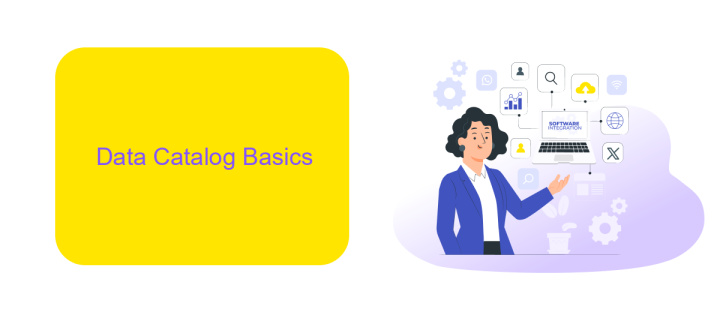Data Catalog Data Integration
In today's data-driven world, efficiently managing and integrating vast amounts of information is crucial for organizational success. A data catalog serves as a comprehensive inventory of data assets, enabling seamless data integration and accessibility. By leveraging a data catalog, businesses can enhance data governance, streamline operations, and foster informed decision-making, ultimately driving innovation and competitive advantage.
Introduction
Data catalogs play a crucial role in the modern data ecosystem, serving as centralized repositories where organizations can store, manage, and discover metadata about their data assets. These catalogs are essential for ensuring data governance, enhancing data quality, and facilitating data integration processes across disparate systems.
- Centralized metadata management
- Enhanced data discovery and accessibility
- Improved data governance and compliance
- Streamlined data integration
Effective data integration is key to leveraging the full potential of data catalogs. Tools like ApiX-Drive simplify this process by allowing seamless integration between various data sources and applications. By automating data workflows and ensuring real-time data synchronization, ApiX-Drive helps organizations maintain data consistency and accuracy, thereby maximizing the value derived from their data catalogs.
Data Catalog Basics

A data catalog is an organized inventory of data assets within an organization. It provides a single reference point for data discovery and management, allowing users to understand, trust, and utilize data efficiently. Data catalogs typically include metadata, data lineage, and data quality information, which help users find relevant data quickly and ensure its reliability. By offering a comprehensive view of data assets, data catalogs facilitate better decision-making and data governance.
Data integration is a crucial aspect of maintaining an effective data catalog. Tools like ApiX-Drive can automate the process of integrating various data sources, ensuring that the catalog remains up-to-date and accurate. ApiX-Drive simplifies the integration process by connecting different applications and data streams, allowing for seamless data flow across platforms. This not only enhances the usability of the data catalog but also ensures that users have access to the most current and relevant data available.
Data Integration Use Cases

Data integration plays a crucial role in modern data management, enabling seamless connectivity between disparate data sources. It helps organizations streamline their operations and make informed decisions based on comprehensive data insights. Here are some common use cases for data integration:
- Customer 360-Degree View: Integrating data from CRM, marketing, and support systems to get a unified view of customer interactions and preferences.
- Business Intelligence: Consolidating data from various databases and applications to provide a single source of truth for analytics and reporting.
- Data Migration: Seamlessly transferring data between old and new systems during upgrades or platform changes.
- Real-Time Data Synchronization: Ensuring that data remains consistent and up-to-date across multiple systems in real-time.
- API Integration: Utilizing services like ApiX-Drive to automate data flows between different applications without extensive coding.
These use cases highlight the importance of data integration in achieving operational efficiency and informed decision-making. Tools like ApiX-Drive simplify the process, allowing businesses to automate and streamline their data workflows effectively.
Benefits of Data Integration

Data integration is a crucial component for modern businesses aiming to leverage their data effectively. By consolidating data from various sources, organizations can gain a comprehensive view of their operations, leading to more informed decision-making and improved efficiency.
One of the primary benefits of data integration is the elimination of data silos. When data is scattered across different systems, it becomes challenging to access and analyze. Integrating these data sources ensures that all relevant information is available in a single, unified platform.
- Improved data quality and consistency
- Enhanced collaboration across departments
- Streamlined business processes
- Better compliance and data governance
- Increased agility in responding to market changes
Services like ApiX-Drive simplify the process of data integration by offering automated workflows and seamless connections between various applications. This not only saves time but also reduces the risk of errors, ensuring that your data is always accurate and up-to-date. By leveraging such tools, businesses can focus more on strategic initiatives rather than getting bogged down by technical complexities.


Data Catalog and Data Integration Best Practices
Implementing a robust data catalog and data integration strategy requires adherence to several best practices. Firstly, ensure comprehensive metadata management. This involves capturing, storing, and maintaining metadata to provide context and improve data discoverability. Regularly update the data catalog to reflect changes in data sources and structures. Additionally, establish clear data governance policies to maintain data quality, integrity, and compliance. This includes defining roles and responsibilities, data stewardship, and setting up data access controls.
For seamless data integration, leverage automation tools like ApiX-Drive to streamline the process. ApiX-Drive simplifies the integration of various data sources by offering pre-built connectors and user-friendly interfaces, reducing manual intervention and errors. Ensure data consistency and reliability by implementing data validation and transformation rules. Regularly monitor and audit integrations to identify and resolve issues promptly. Finally, foster collaboration between data engineers, analysts, and business stakeholders to ensure the data integration efforts align with organizational goals and deliver actionable insights.
FAQ
What is a Data Catalog?
Why is Data Integration important?
How can I automate Data Integration processes?
What are the key features to look for in a Data Catalog?
How do I ensure data quality in Data Integration?
Time is the most valuable resource for business today. Almost half of it is wasted on routine tasks. Your employees are constantly forced to perform monotonous tasks that are difficult to classify as important and specialized. You can leave everything as it is by hiring additional employees, or you can automate most of the business processes using the ApiX-Drive online connector to get rid of unnecessary time and money expenses once and for all. The choice is yours!

